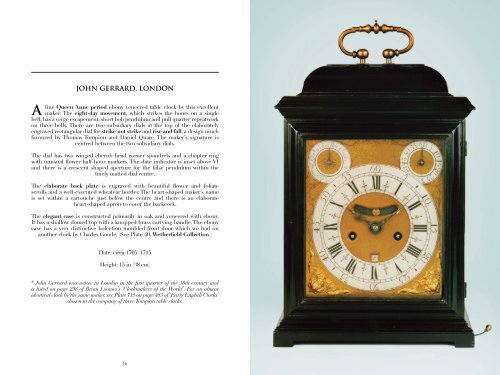Catalogue - Antique Clocks and Barometers
Catalogue - Antique Clocks and Barometers
Catalogue - Antique Clocks and Barometers
Create successful ePaper yourself
Turn your PDF publications into a flip-book with our unique Google optimized e-Paper software.
A<br />
JOHN GERRARD, LONDON<br />
fine Queen Anne period ebony veneered table clock by this excellent<br />
maker. The eight-day movement, which strikes the hours on a single<br />
bell, has a verge escapement, short bob pendulum <strong>and</strong> pull quarter repeatwork<br />
on three bells. There are two subsidiary dials at the top of the elaborately<br />
engraved rectangular dial for strike/not strike <strong>and</strong> rise <strong>and</strong> fall, a design much<br />
favoured by Thomas Tompion <strong>and</strong> Daniel Quare. The maker’s signature is<br />
centred between the two subsidiary dials.<br />
The dial has two winged cherub head corner sp<strong>and</strong>rels <strong>and</strong> a chapter ring<br />
with unusual flower half-hour markers. The date indicator is inset above VI<br />
<strong>and</strong> there is a crescent shaped aperture for the false pendulum within the<br />
finely matted dial centre.<br />
The elaborate back plate is engraved with beautiful flower <strong>and</strong> foliate<br />
scrolls <strong>and</strong> a well-executed wheatear border. The heart-shaped maker’s name<br />
is set within a cartouche just below the centre <strong>and</strong> there is an elaborate<br />
heart-shaped apron to cover the backcock.<br />
The elegant case is constructed primarily in oak <strong>and</strong> veneered with ebony.<br />
It has a shallow domed top with a knopped brass carrying h<strong>and</strong>le. The ebony<br />
case has a very distinctive bolection moulded front door which we had on<br />
another clock by Charles Goode. (See Plate 40, Wetherfield Collection.)<br />
Date: circa 1705–1715<br />
Height: 15 in (38 cm)<br />
* John Gerrard was active in London in the first quarter of the 18th century <strong>and</strong><br />
is listed on page 298 of Brian Loomes’s ‘Clockmakers of the World’. For an almost<br />
identical clock by the same maker, see Plate 715 on page 483 of ‘Early English <strong>Clocks</strong>’<br />
shown in the company of three Tompion table clocks.<br />
16 17


